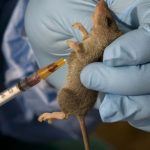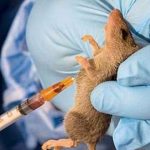The death toll from Lassa fever in Nigeria this year has risen to 104. This is according to the Nigeria Centre for Disease Control (NCDC).
The NCDC reported 636 confirmed Lassa fever cases since the beginning of the year in its week eight Lassa fever situation report.
The NCDC said from January to February 26, 2023, a total of 2,978 suspected cases were recorded.
However, based on the current death toll, the public health institution determined that the outbreak’s case-fatality ratio was 16.4 percent.
It also added that the predominant age group affected in the country was 21 to 30 years, with the male-to-female ratio for confirmed cases being 10:9.
According to the World Health Organisation, Lassa fever is an acute viral hemorrhagic illness caused by the Lassa virus, a member of the arenavirus family of viruses. Humans usually become infected with the Lassa virus through exposure to food or household items contaminated with the urine or feaces of infected Mastomys rats. The disease is endemic in the rodent population in parts of West Africa.
Lassa fever is endemic in Benin, Ghana, Guinea, Liberia, Mali, Sierra Leone, Togo, and Nigeria, but it is also likely in other West African countries. Person-to-person infections and laboratory transmission can also occur, particularly in healthcare settings where infection prevention and control measures are inadequate.
The death toll from Lassa fever in Nigeria this year has risen to 104. This is according to the Nigeria Centre for Disease Control (NCDC).
The NCDC reported 636 confirmed Lassa fever cases since the beginning of the year in its week eight Lassa fever situation report.
The NCDC said from January to February 26, 2023, a total of 2,978 suspected cases were recorded.
However, based on the current death toll, the public health institution determined that the outbreak’s case-fatality ratio was 16.4 percent.
It also added that the predominant age group affected in the country was 21 to 30 years, with the male-to-female ratio for confirmed cases being 10:9.
According to the World Health Organisation, Lassa fever is an acute viral hemorrhagic illness caused by the Lassa virus, a member of the arenavirus family of viruses. Humans usually become infected with the Lassa virus through exposure to food or household items contaminated with the urine or feaces of infected Mastomys rats. The disease is endemic in the rodent population in parts of West Africa.
Lassa fever is endemic in Benin, Ghana, Guinea, Liberia, Mali, Sierra Leone, Togo, and Nigeria, but it is also likely in other West African countries. Person-to-person infections and laboratory transmission can also occur, particularly in healthcare settings where infection prevention and control measures are inadequate.
The death toll from Lassa fever in Nigeria this year has risen to 104. This is according to the Nigeria Centre for Disease Control (NCDC).
The NCDC reported 636 confirmed Lassa fever cases since the beginning of the year in its week eight Lassa fever situation report.
The NCDC said from January to February 26, 2023, a total of 2,978 suspected cases were recorded.
However, based on the current death toll, the public health institution determined that the outbreak’s case-fatality ratio was 16.4 percent.
It also added that the predominant age group affected in the country was 21 to 30 years, with the male-to-female ratio for confirmed cases being 10:9.
According to the World Health Organisation, Lassa fever is an acute viral hemorrhagic illness caused by the Lassa virus, a member of the arenavirus family of viruses. Humans usually become infected with the Lassa virus through exposure to food or household items contaminated with the urine or feaces of infected Mastomys rats. The disease is endemic in the rodent population in parts of West Africa.
Lassa fever is endemic in Benin, Ghana, Guinea, Liberia, Mali, Sierra Leone, Togo, and Nigeria, but it is also likely in other West African countries. Person-to-person infections and laboratory transmission can also occur, particularly in healthcare settings where infection prevention and control measures are inadequate.
The death toll from Lassa fever in Nigeria this year has risen to 104. This is according to the Nigeria Centre for Disease Control (NCDC).
The NCDC reported 636 confirmed Lassa fever cases since the beginning of the year in its week eight Lassa fever situation report.
The NCDC said from January to February 26, 2023, a total of 2,978 suspected cases were recorded.
However, based on the current death toll, the public health institution determined that the outbreak’s case-fatality ratio was 16.4 percent.
It also added that the predominant age group affected in the country was 21 to 30 years, with the male-to-female ratio for confirmed cases being 10:9.
According to the World Health Organisation, Lassa fever is an acute viral hemorrhagic illness caused by the Lassa virus, a member of the arenavirus family of viruses. Humans usually become infected with the Lassa virus through exposure to food or household items contaminated with the urine or feaces of infected Mastomys rats. The disease is endemic in the rodent population in parts of West Africa.
Lassa fever is endemic in Benin, Ghana, Guinea, Liberia, Mali, Sierra Leone, Togo, and Nigeria, but it is also likely in other West African countries. Person-to-person infections and laboratory transmission can also occur, particularly in healthcare settings where infection prevention and control measures are inadequate.
The death toll from Lassa fever in Nigeria this year has risen to 104. This is according to the Nigeria Centre for Disease Control (NCDC).
The NCDC reported 636 confirmed Lassa fever cases since the beginning of the year in its week eight Lassa fever situation report.
The NCDC said from January to February 26, 2023, a total of 2,978 suspected cases were recorded.
However, based on the current death toll, the public health institution determined that the outbreak’s case-fatality ratio was 16.4 percent.
It also added that the predominant age group affected in the country was 21 to 30 years, with the male-to-female ratio for confirmed cases being 10:9.
According to the World Health Organisation, Lassa fever is an acute viral hemorrhagic illness caused by the Lassa virus, a member of the arenavirus family of viruses. Humans usually become infected with the Lassa virus through exposure to food or household items contaminated with the urine or feaces of infected Mastomys rats. The disease is endemic in the rodent population in parts of West Africa.
Lassa fever is endemic in Benin, Ghana, Guinea, Liberia, Mali, Sierra Leone, Togo, and Nigeria, but it is also likely in other West African countries. Person-to-person infections and laboratory transmission can also occur, particularly in healthcare settings where infection prevention and control measures are inadequate.
The death toll from Lassa fever in Nigeria this year has risen to 104. This is according to the Nigeria Centre for Disease Control (NCDC).
The NCDC reported 636 confirmed Lassa fever cases since the beginning of the year in its week eight Lassa fever situation report.
The NCDC said from January to February 26, 2023, a total of 2,978 suspected cases were recorded.
However, based on the current death toll, the public health institution determined that the outbreak’s case-fatality ratio was 16.4 percent.
It also added that the predominant age group affected in the country was 21 to 30 years, with the male-to-female ratio for confirmed cases being 10:9.
According to the World Health Organisation, Lassa fever is an acute viral hemorrhagic illness caused by the Lassa virus, a member of the arenavirus family of viruses. Humans usually become infected with the Lassa virus through exposure to food or household items contaminated with the urine or feaces of infected Mastomys rats. The disease is endemic in the rodent population in parts of West Africa.
Lassa fever is endemic in Benin, Ghana, Guinea, Liberia, Mali, Sierra Leone, Togo, and Nigeria, but it is also likely in other West African countries. Person-to-person infections and laboratory transmission can also occur, particularly in healthcare settings where infection prevention and control measures are inadequate.
The death toll from Lassa fever in Nigeria this year has risen to 104. This is according to the Nigeria Centre for Disease Control (NCDC).
The NCDC reported 636 confirmed Lassa fever cases since the beginning of the year in its week eight Lassa fever situation report.
The NCDC said from January to February 26, 2023, a total of 2,978 suspected cases were recorded.
However, based on the current death toll, the public health institution determined that the outbreak’s case-fatality ratio was 16.4 percent.
It also added that the predominant age group affected in the country was 21 to 30 years, with the male-to-female ratio for confirmed cases being 10:9.
According to the World Health Organisation, Lassa fever is an acute viral hemorrhagic illness caused by the Lassa virus, a member of the arenavirus family of viruses. Humans usually become infected with the Lassa virus through exposure to food or household items contaminated with the urine or feaces of infected Mastomys rats. The disease is endemic in the rodent population in parts of West Africa.
Lassa fever is endemic in Benin, Ghana, Guinea, Liberia, Mali, Sierra Leone, Togo, and Nigeria, but it is also likely in other West African countries. Person-to-person infections and laboratory transmission can also occur, particularly in healthcare settings where infection prevention and control measures are inadequate.
The death toll from Lassa fever in Nigeria this year has risen to 104. This is according to the Nigeria Centre for Disease Control (NCDC).
The NCDC reported 636 confirmed Lassa fever cases since the beginning of the year in its week eight Lassa fever situation report.
The NCDC said from January to February 26, 2023, a total of 2,978 suspected cases were recorded.
However, based on the current death toll, the public health institution determined that the outbreak’s case-fatality ratio was 16.4 percent.
It also added that the predominant age group affected in the country was 21 to 30 years, with the male-to-female ratio for confirmed cases being 10:9.
According to the World Health Organisation, Lassa fever is an acute viral hemorrhagic illness caused by the Lassa virus, a member of the arenavirus family of viruses. Humans usually become infected with the Lassa virus through exposure to food or household items contaminated with the urine or feaces of infected Mastomys rats. The disease is endemic in the rodent population in parts of West Africa.
Lassa fever is endemic in Benin, Ghana, Guinea, Liberia, Mali, Sierra Leone, Togo, and Nigeria, but it is also likely in other West African countries. Person-to-person infections and laboratory transmission can also occur, particularly in healthcare settings where infection prevention and control measures are inadequate.













